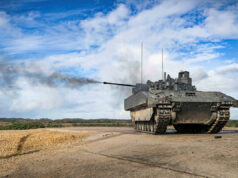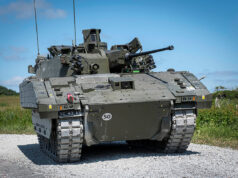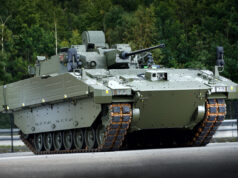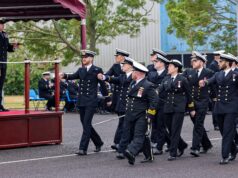Today at the International Armoured Vehicles Conference in London, BAE presented the next phase of development for the CV90 Infantry Fighting Vehicle.
This was done with the launch of the new CV90 MkIV. This fifth generation of the company’s IFV family represents the next step for the CV90 concept.
BAE say that the new MkIV offers substantial capability upgrades, including increased drive train capabilities and active damping technology to improve battlefield speeds and handling. The new vehicle also features the latest NATO-standard Electronic Architecture to meet customer demands for sensor integration and the implementation of autonomous systems.
BAE Systems intends to offer the CV90 MkIV to the Czech Republic in the ongoing armoured vehicle competition to replace the Czech Army’s legacy fleet of BMP-II IFVs.
“We are proud and excited to present the next step in the development of CV90,” said Tommy Gustafsson-Rask, vice president and general manager for BAE Systems’ Hägglunds business.
“The MkIV will now be available to both current and future users of the CV90, who can take full advantage of this combat-proven vehicle’s ongoing development and benefit from these new capabilities. This approach provides the leading combination of a proven low-risk solution for the most modern IFV for future growth.”
According to the manufacturer:
“The CV90 IFV is a modern, adaptable, and combat-proven vehicle with 1,280 vehicles in 15 variants sold to seven nations, including four NATO allies. The most recent generation of the CV90, under delivery for the Norwegian Army, is one of the most modern IFVs in production in the world.
The CV90 MkIV includes a new engine with up to 1,000 horsepower and the latest upgraded X300 heavy-duty transmission. The Gross Vehicle Weight Rating is increased from 35 tonnes to 37 tonnes, meaning users will benefit from two tonnes of extra payload without a decrease in vehicle agility, with the same level of protection. This gives any users an unrivalled amount of potential for future growth.
The MkIV capability upgrades also enable the full implementation of BAE Systems’ iFighting™ concept. iFighting™ — or intelligent fighting — is the company’s vision for the future complex battlefield. iFighting™ supports the vehicle’s crew with significantly enhanced situational awareness, aiding the decision making process. This safeguards the vigilance and the endurance of the crew, while ensuring peak performance for the whole system. iFighting™ achieves improved ergonomics, more advanced autonomous support, augmented reality, and the possibility of remote operation.”
The CV90 is currently in use in Denmark, Estonia, Finland, Norway, Sweden, Switzerland, and The Netherlands.













Does this have any similarity to the new British IFV? Is this the model Britain is currently building for itself or is this completely unrelated?
The CV90 was trialled for the role, but wasn’t chosen. Instead we went with ASCOD. Which personally id say was a shame.
1000bhp!
UK Ajax ? 800bhp. Ajaxs probably weighs more also, SHM.
No, the new Scania engine in the above CV-90 mk4
Add to that the active dampening and new suspension setup the worked with McClaren F1 with.
A beast.
I’m not into armoured vehicles, so could someone please advise me. How does this or the Ajax compare with the German Puma?
The CV90 is cheaper and has actually been used operationally and will continue to do so.
I’d pick the CV90 over the other two every day of the week.
I do like the idea of the 40mm Ajax gun though….. shame there is no ATGM integration.
Thanks
What the UK should be using instead of foreign designed and built Ajax
You’re aware this was designed by Hägglunds AB. in Sweden?
CV90 is originally Swedish.
The CV90 is built in Sweden.
Does the U.K. build anything of our own?
Hagglunds was bought by BAE Systems a few years ago, and with that purchase came their entire catalogue of products. Hence why it is built there – it was built before BAE bought them.
The UK used to be build tanks but BAE closed its tank factory some years ago. Not sure how difficult it would be for them to get it going again. A tank, unlike an aircraft, is not that complex.
While not as complex as an aircraft. Modern tanks are very complex and labor intensive to build. Now AFVs and IFVs are much easier. Less advanced armor, smaller engine, fewer transmission changes, and doesn’t have to place a 120mm shell kilometers away from it’s target in a 1 meter target.
Ajax is being built here Gwent and Merthyr Tydfil. Last time I looked outside of my house I was here in Wales.
Surely we have a military requirement for 20,000 vehicles for the military. So that is circa 1000 per year of all types. Doesn’t really seem to be enough to keep a factory going I am afraid, but I could be wrong.